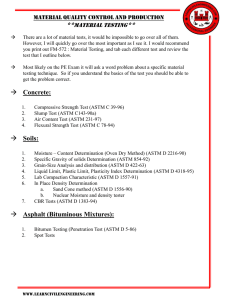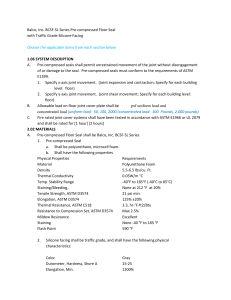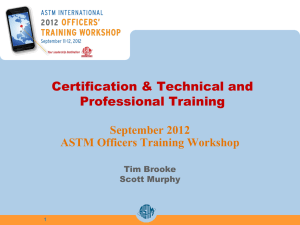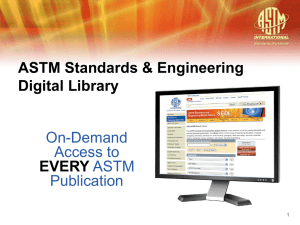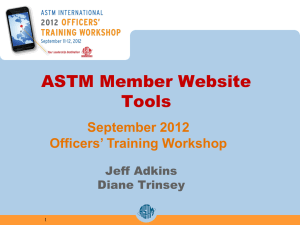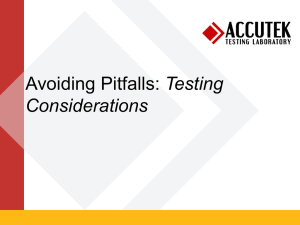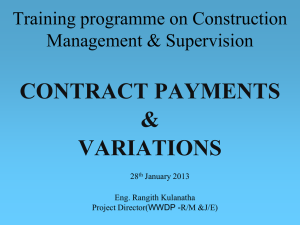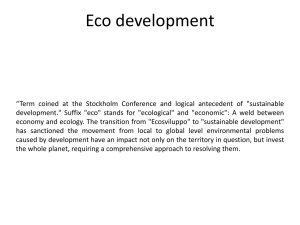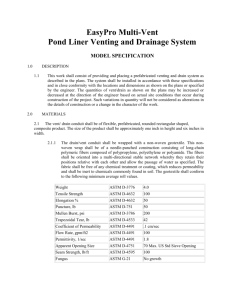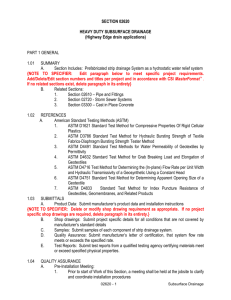quality
advertisement
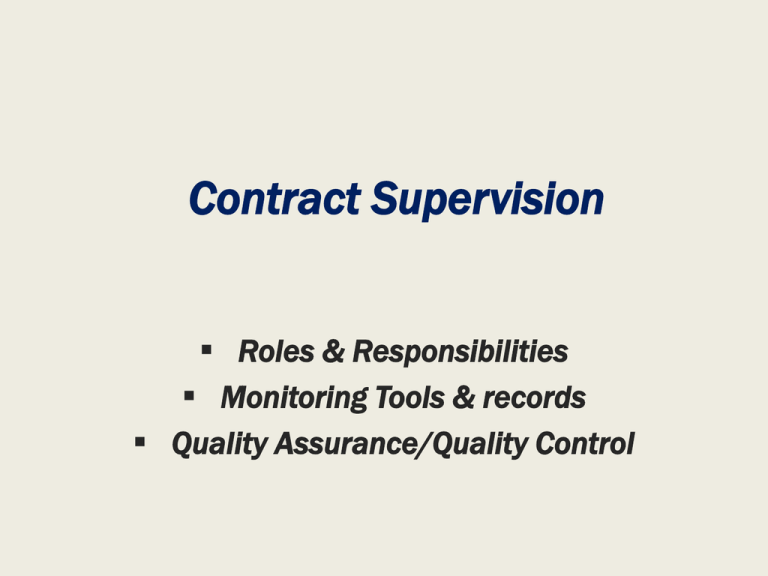
Contract Supervision Roles & Responsibilities Monitoring Tools & records Quality Assurance/Quality Control Why we need Contracts? Binding For commitment Share Responsibilities Towards Agreed terms Fulfill Satisfy Obligations Requirements Construction Management Training Module-1 2 OFFER Consideration ACCEPTANCE (Value/ Causa) CONTRACT One party RIGHT To other party RISK INTEREST DETREMENT PROFIT LOSS BENEFIT Construction Management Training Module-1 FOREBEARRANCE 3 Key Elements of a Contract TERMS EXPRESSED ( Verbal/Writing) CONDITIONS WARRANTIES IMPLIED ( automatically) STATUTORY/TRADE CUSTOMS Conditions of Contract Conditions GENERAL ( Universal) Policies Definitions Dispute resolutions PARTICULAR ( Suit to Environment) Execution Deviations from General Conditions Time Frame Specific applications Construction Management Training Payment Terms Particular terms to suit 5 Module-1 ICTAD CONDITIONS OF CONTRACTSAVAILABLE PUBLICATIONS ICTAD/SBD/01 - Standard Bidding Document for Procurement of Works ( Vol 1&2, Yr 2007) ICTAD/SBD/02 - Standard Bidding Document for Major Contracts ( Vol 1&2, Yr 2007) ICTAD/SBD/03 - Standard Bidding Document for Minor Contracts ( Vol 1&2, Yr 2007) ICTAD/SBD/04 - Standard Bidding Document for Design & Build Contracts ( Vol 1&2, Yr 2007) SCA/3/2 - Specifications for Water Supply, Sewerage & Storm water drainage ( 2nd Edition April 2002) Construction Management Training Module-1 6 Parties Involved in Contract Supervision Employer * Site Representatives/Consultants Engineer *Representatives Contractor *Site Agents *Sub Contractors What are the Engineer’s duties and powers? Supervision Instructions Extensions & Suspension of Contracts Valuation & Claims Mediation at Contractual Disputes Engineer’s powers - Supervision Supervision •Organization & Correspondence •Agreed Contactor’s work programs. •Examining contractor’s proposal’s & Method Statement and approving •Acceptance of tests at completion and ordering commissioning of elements. •Comment satisfaction Responsibilities of Engineer’s Representatives/ site agents Act according to delegated functions Watch, supervise & examine site works with tests Adherent to the orders/ decision of the engineer. Records on extra or additional works, pertaining to the extension of time • Joint admeasurements • Order stoppage of work at unsafe situations / noncompliance with specification • Assist Engineer on valuation/ claims • • • • Monitoring Tools/methods Audit measures the cost or value of inputs, such as materials and manpower, in relation to producing the outputs. Audit could be in both Technical & Financial Aspects. Audit mainly measures efficiency using quantitative methods. Management Information System (MIS) is a process by which raw data is collected, summarized and given to the management of a project or program. It includes computeraided information systems and is meant to alert the managers who then take decisions. MIS is useful for efficiency questions; however, ensuring the validity/accuracy of information can be difficult. Performance monitoring (also called performance evaluation) checks what is achieved and the expenditure for the different achievements for the project. The validity of performance monitoring can be problematic when performance monitoring is connected to the release of payments. Auto-monitoring (also called auto-evaluation) originally meant assessment by an individual or a small group of their own activities judged against a set of indicator, which they set for themselves. The concept has since broadened to mean increasing the capacity of the project personnel and stakeholders for monitoring their own programs and activities taking control of their own programs. Both qualitative and quantitative methods are used. 11 Construction Records for Contract Monitoring Contractor’s Submittals Submittal register ( Program for submittals) Master Work Program & Individual programs for sub-components Construction Records Official site Log book Resource utilization daily records o Supervisory & Labor o Plant & Machinery Method Statements for works including temporary works Daily Weather Records or weather charts Material Test reports and applicable standards Daily work records ( DPR) Manufacturer’s performance or test certificates Safety & Environment Management Plan during Construction Approvals • • • • Pre-inspection records Prior approval forms ( setting out, Concrete, etc) Test witness records ( site & laboratory) Testing & commissioning approval forms Quality Assurance & Quality Control at Construction What is Desired Quality? • Achieved by how & whom? • Shall be an inbuilt element of the design documentation ( design brief) and as well as at the Contract documentation ( specific terms) • “Quality Culture” is a important feature at the construction and shall be a achieved through “team spirit “ of both the Engineer /Engineer’s representatives and the Contractor • Should not strict on “ perfection” or “Zero defects” thereby tolerances and flexibility shall be clearly spelled out at the inception of work and at agreed method statements & shop drawings • Quality assurance should be ensured through standard quality tests and with trade practices and should disclose the satisfaction of quality of end product after test proceedings • “ Quality is never an accidently achievement and it always the result of intelligent effort” Quality of construction attributes appearance, aesthetic, stability, strength and durability • Construction quality is a relative term and thereby before controlling quality one must have a “reference quality level” • Quality at construction work shall involve cost & time and thereby tread-offs or balance to be considered with “ complementary cost” and related “time factors” • Technical quality shall be governed by “ Standards” but Functional or Operational quality is the desired level for intended purpose Standard Quality Tests Field Tests Laboratory Tests Long & Short Duration Pumping Tests • Quality of Water for concreting ( BS 3148) Standard Compaction Tests for dry density ( ASTM D 1557, BS 1337) • Fine & Coarse Aggregates for Concreting (BS 882 or ASTM C33) Hydrostatic Pressure Testing for Pipe Lines ( BS 8010, AWWA C 600, AWWA C 907) ) • Sampling & Testing of Reinforcement ( BS 4449, Appendix C) • Concrete Mix Design ( BS 8007, BS8110, BS 5328) • Admixtures ( ASTM C 494 or BS 5075) Sterilization or Disinfection of completed pipe lines ( ANSI/AWWA C 651) • Curing Compounds ( ASTM C 309) Trial Mix for Concreting (ASTM C 143) • Sampling & Testing of Fresh & Harden Concrete ( BS 1881 or ASTM C31 & 39) Slump Test for Concreting ( ASTM C 143) • Sampling & Testing of Cement Blocks ( BS 6073 or ASTM C 90) Hydrostatic Pressure Testing for Water Retaining Structures ( BS 8007) Some Rural Constructions Some Rural Constructions Practical Aspects/Areas to Give Thought to ensure end Quality at WSS • • • • • • • Site layouts Construction sequence at congested work Depth of pipes & bedding materials Locating washouts & air valves Laying pipes in hilly terrains Mix designs and admixtures for Gr 35 concrete Temperature control at concreting and placing of construction joints at water tanks • Color selection for structural elements and buildings and final finishing techniques • Approving methods for defect repairs Thanking you for your keen interest and concerns on quality construction at peaceful working environment Sanath Fernando
